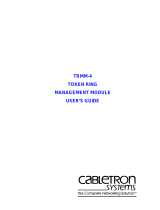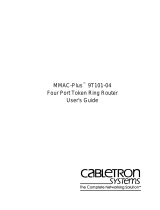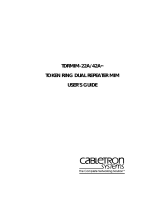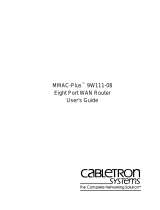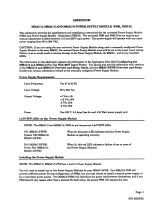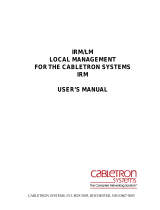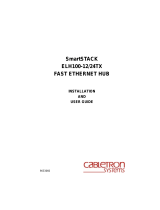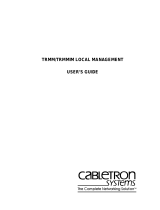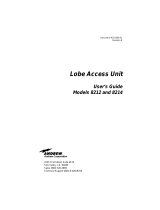Page is loading ...

TRMM-2
TOKEN RING
MANAGEMENT MODULE
USER’S GUIDE


QR-1
TRMM-2 QUICK REFERENCE
QR.1 SWITCHBLOCK SW1 SETTINGS
Switchblock SW1 With Factory Default Settings
Switch Function
(Default settings shown in
bold
)
1 Ring speed of FNB Ring 1 for all port switching MIMs.
On – 16 Mbps
; Off – 4 Mbps
2 Ring speed of STATION port interface.
On – 16 Mbps
; Off – 4 Mbps
3 Ring speed of FNB Ring 2 for all port switching MIMs.
On – 16 Mbps
; Off – 4 Mbps
4 Toggle to clear NVRAM.
5 Unused
6 Unused
7 Ring speed of FNB Ring 3 for all port switching MIMs.
On – 16 Mbps
; Off – 4 Mbps
8 Ring speed of FNB Ring 4 for all port switching MIMs.
On – 16 Mbps
; Off – 4 Mbps
JP1
JP2
FNB Ring 2
FNB Ring 4
FNB Ring 3
NVRAM Clear
SW1
Station Port
(Interface 2)
FNB Ring 1
(Interface 1)
unused
JP2
Forced Network
Download
SW1

TRMM-2 QUICK REFERENCE
QR-2
QR.2 LED STATUS DESCRIPTIONS
NOTE
The TRMM-2 does not control the ring speeds of single-ring
MIMs.
LED Status Meaning
CPU
OFF No power to module.
GREEN Testing and booting are nearly complete.
Blinking
GREEN
Operational.
RED Module is resetting or has detected errors.
Blinking RED Module has failed self-tests.
LWRP
OFF The left connection is
not
left wrapped.
AMBER
Left connection has been wrapped. FNB Ring 1
segment has been isolated from all other MIMs.
16 Mb
AMBER Interface ring speed is set to 16 Mbps.
OFF Interface ring speed is set to 4 Mbps
.
XMT
Flashing
GREEN
Information transmission by the TRMM-2
.
Blinking RED Beaconing condition on the ring.
OFF Interface is inactive.
RED Interface is disabled.
RCV
Flashing
AMBER
Network activity.
RED Interface disabled.
NSRT
GREEN
Interface is inserted into the ring and is participating
as a station on that ring.
OFF Interface is not inserted into any ring.

TRMM-2 QUICK REFERENCE
QR-3
QR.3 CPU - CENTRAL PROCESSOR UNIT
The
CPU
LED indicates the operational status of the TRMM-2’s
processor. During start-up, the
CPU
LED indicates a variety of
operational states, as shown in the following table.
State(s) Meaning
OFF The module is not receiving power.
Briefly turns RED The module is resetting.
GREEN The module has passed its power check.
AMBER
Performing diagnostic checks.
(It will stay here for a while.)
Cycles through AMBER,
OFF, GREEN, and OFF for a
while.
Testing and booting period has begun.
Momentarily to RED, but
continues cycling.
The module has detected errors during
the start-up sequence, but has continued
the process.
If blinking RED,
(continuously)
The module has failed self-tests.
GREEN Testing and booting are nearly complete.
Blinking GREEN
The module is fully functional.
The CPU
LED stays BLINKING GREEN under
normal operation.

TRMM-2 QUICK REFERENCE
QR-4

i
NOTICE
Cabletron Systems reserves the right to make changes in specifications and other information
contained in this document without prior notice. The reader should in all cases consult Cabletron
Systems to determine whether any such changes have been made.
The hardware, firmware, or software described in this manual is subject to change without notice.
IN NO EVENT SHALL CABLETRON SYSTEMS BE LIABLE FOR ANY INCIDENTAL,
INDIRECT, SPECIAL, OR CONSEQUENTIAL DAMAGES WHATSOEVER (INCLUDING BUT
NOT LIMITED TO LOST PROFITS) ARISING OUT OF OR RELATED TO THIS MANUAL OR
THE INFORMATION CONTAINED IN IT, EVEN IF CABLETRON SYSTEMS HAS BEEN
ADVISED OF, KNOWN, OR SHOULD HAVE KNOWN, THE POSSIBILITY OF SUCH
DAMAGES.
Copyright 1997 by Cabletron Systems, Inc., P.O. Box 5005, Rochester, NH 03866-5005
All Rights Reserved
Printed in the United States of America
Order Number: 9031287-02 September 1997
Cabletron
Systems
,
SPECTRUM
,
LANVIEW
,
FNB
,
and MMAC
are registered trademarks and
Element Manager
,
MIM
, and
TRMM-2
are trademarks of Cabletron Systems, Inc.
VT100
is a trademark of Digital Equipment Corporation.
All other product names mentioned in this manual may be trademarks or registered trademarks of
their respective companies.
FCC NOTICE
This device complies with Part 15 of the FCC rules. Operation is subject to the following two
conditions: (1) this device may not cause harmful interference, and (2) this device must accept any
interference received, including interference that may cause undesired operation.
NOTE:
This equipment has been tested and found to comply with the limits for a Class A digital
device, pursuant to Part 15 of the FCC rules. These limits are designed to provide reasonable
protection against harmful interference when the equipment is operated in a commercial environment.
This equipment uses, generates, and can radiate radio frequency energy and if not installed in
accordance with the operator’s manual, may cause harmful interference to radio communications.
Operation of this equipment in a residential area is likely to cause interference in which case the user
will be required to correct the interference at his own expense.
WARNING:
Changes or modifications made to this device which are not expressly approved by the
party responsible for compliance could void the user’s authority to operate the equipment.
Only qualified personnel should perform installation
procedures.
Printed on Recycled Paper

NOTICE
ii
DOC NOTICE
This digital apparatus does not exceed the Class A limits for radio noise emissions from digital
apparatus set out in the Radio Interference Regulations of the Canadian Department of
Communications.
Le présent appareil numérique n’émet pas de bruits radioélectriques dépassant les limites applicables
aux appareils numériques de la class A prescrites dans le Règlement sur le brouillage radioélectrique
édicté par le ministère des Communications du Canada.
VCCI NOTICE
This is a Class A product based on the standard of the Voluntary Control Council for Interference by
Information Technology Equipment (VCCI). If this equipment is used in a domestic environment,
radio disturbance may arise. When such trouble occurs, the user may be required to take corrective
actions.
CABLETRON SYSTEMS, INC. PROGRAM LICENSE AGREEMENT
IMPORTANT:
Before utilizing this product, carefully read this License Agreement.
This document is an agreement between you, the end user, and Cabletron Systems, Inc. (“Cabletron”)
that sets forth your rights and obligations with respect to the Cabletron software program (the
“Program”) contained in this package. The Program may be contained in firmware, chips or other
media. BY UTILIZING THE ENCLOSED PRODUCT, YOU ARE AGREEING TO BECOME
BOUND BY THE TERMS OF THIS AGREEMENT, WHICH INCLUDES THE LICENSE AND
THE LIMITATION OF WARRANTY AND DISCLAIMER OF LIABILITY. IF YOU DO NOT
AGREE TO THE TERMS OF THIS AGREEMENT, PROMPTLY RETURN THE UNUSED
PRODUCT TO THE PLACE OF PURCHASE FOR A FULL REFUND.
CABLETRON SOFTWARE PROGRAM LICENSE
1. LICENSE
. You have the right to use only the one (1) copy of the Program provided in this
package subject to the terms and conditions of this License Agreement.
You may not copy, reproduce or transmit any part of the Program except as permitted by the
Copyright Act of the United States or as authorized in writing by Cabletron.
2. OTHER RESTRICTIONS. You may not reverse engineer, decompile, or disassemble the
Program.
3. APPLICABLE LAW. This License Agreement shall be interpreted and governed under the laws
and in the state and federal courts of New Hampshire. You accept the personal jurisdiction and
venue of the New Hampshire courts.

NOTICE
iii
EXCLUSION OF WARRANTY AND DISCLAIMER OF LIABILITY
1. EXCLUSION OF
WARRANTY. Except as may be specifically provided by Cabletron in
writing, Cabletron makes no warranty, expressed or implied, concerning the Program (including
its documentation and media).
CABLETRON DISCLAIMS ALL WARRANTIES, OTHER THAN THOSE SUPPLIED TO
YOU BY CABLETRON IN WRITING, EITHER EXPRESSED OR IMPLIED, INCLUDING
BUT NOT LIMITED TO IMPLIED WARRANTIES OF MERCHANTABILITY AND
FITNESS FOR A PARTICULAR PURPOSE, WITH RESPECT TO THE PROGRAM, THE
ACCOMPANYING WRITTEN MATERIALS, AND ANY ACCOMPANYING HARDWARE.
2. NO LIABILITY FOR CONSEQUENTIAL DAMAGES. IN NO EVENT SHALL
CABLETRON OR ITS SUPPLIERS BE LIABLE FOR ANY DAMAGES WHATSOEVER
(INCLUDING, WITHOUT LIMITATION, DAMAGES FOR LOSS OF BUSINESS,
PROFITS, BUSINESS INTERRUPTION, LOSS OF BUSINESS INFORMATION, SPECIAL,
INCIDENTAL, CONSEQUENTIAL, OR RELIANCE DAMAGES, OR OTHER LOSS)
ARISING OUT OF THE USE OR INABILITY TO USE THIS CABLETRON PRODUCT,
EVEN IF CABLETRON HAS BEEN ADVISED OF THE POSSIBILITY OF SUCH
DAMAGES. BECAUSE SOME STATES DO NOT ALLOW THE EXCLUSION OR
LIMITATION OF LIABILITY FOR CONSEQUENTIAL OR INCIDENTAL DAMAGES, OR
ON THE DURATION OR LIMITATION OF IMPLIED WARRANTIES, IN SOME
INSTANCES THE ABOVE LIMITATIONS AND EXCLUSIONS MAY NOT APPLY TO
YOU.
UNITED STATES GOVERNMENT RESTRICTED RIGHTS
The enclosed product (a) was developed solely at private expense; (b) contains “restricted computer
software” submitted with restricted rights in accordance with Section 52227-19 (a) through (d) of the
Commercial Computer Software - Restricted Rights Clause and its successors, and (c) in all respects
is proprietary data belonging to Cabletron and/or its suppliers.
For Department of Defense units, the product is licensed with “Restricted Rights” as defined in the
DoD Supplement to the Federal Acquisition Regulations, Section 52.227-7013 (c) (1) (ii) and its
successors, and use, duplication, disclosure by the Government is subject to restrictions as set forth in
subparagraph (c) (1) (ii) of the Rights in Technical Data and Computer Software clause at
252.227-7013. Cabletron Systems, Inc., 35 Industrial Way, Rochester, New Hampshire 03867-0505.

NOTICE
iv
DECLARATION OF CONFORMITY
Application of Council Directive(s):
89/336/EEC
73/23/EEC
Manufacturer’s Name:
Cabletron Systems, Inc.
Manufacturer’s Address:
35 Industrial Way
PO Box 5005
Rochester, NH 03867
European Representative Name:
Mr. J. Solari
European Representative Address:
Cabletron Systems Limited
Nexus House, Newbury Business Park
London Road, Newbury
Berkshire RG13 2PZ, England
Conformance to Directive(s)/Product Standards:
EC Directive 89/336/EEC
EC Directive 73/23/EEC
EN 55022
EN 50082-1
EN 60950
Equipment Type/Environment:
Networking Equipment, for use in a
Commercial or Light
Industrial
Environment.
We the undersigned, hereby declare, under our sole responsibility, that the equipment packaged
with this notice conforms to the above directives.
Manufacturer Legal Representative in Europe
Mr. Ronald Fotino Mr. J. Solari
___________________________________ ___________________________________
Full Name Full Name
Principal Compliance Engineer Managing Director - E.M.E.A.
___________________________________ ___________________________________
Title Title
Rochester, NH, USA Newbury, Berkshire, England
___________________________________ ___________________________________
Location Location

v
CONTENTS
PREFACE
CHAPTER 1 INTRODUCTION
1.1 TRMM-2 Functional Overview.....................................................1-2
1.1.1 Port Assignment .............................................................1-2
1.1.2 Ring Poll Failure Recovery .............................................1-3
1.1.3 Network Management.....................................................1-3
1.1.4 Dividing Stations Among Rings ......................................1-4
1.1.5 Segmenting The FNB For Additional Rings....................1-5
1.1.6 Module Bypassing, Ring Bypassing, And Port Disabling 1-6
1.1.7 STATION Port Interface..................................................1-7
1.1.8 Ring Speed Assignments ...............................................1-7
1.1.9 Automatic Configuration At Power-Up............................1-8
1.1.10 RMON Functionality........................................................1-8
1.1.11 SNMP Traps ...................................................................1-8
1.1.12 Ring Security ..................................................................1-8
1.1.13 Automatic Beacon Recovery Process (ABRP) ...............1-9
1.1.14 Access To MIB Libraries.................................................1-9
1.1.15 TFTP Download Of Flash Image ....................................1-9
1.1.16 UPS Monitoring...............................................................1-9
1.2 User Access To Management Controls.....................................1-10
1.2.1 COM Ports....................................................................1-10
1.2.2 Telnet............................................................................1-11
1.2.3 Remote Network Management Applications.................1-11
1.3 Front Panel Features.................................................................1-11
1.3.1 LANVIEW LEDs............................................................1-11
1.3.2 Reset Button.................................................................1-11

CONTENTS
vi
CHAPTER 2 INSTALLATION
2.1 Unpacking And Handling The TRMM-2 .......................................2-1
2.2 Setting Switches And Jumpers ....................................................2-2
2.2.1 Setting FNB Ring Speeds ...............................................2-2
2.2.2 Setting The STATION Port Interface Ring Speed...........2-4
2.2.3 Clearing NVRAM.............................................................2-4
2.2.4 Forced Network Download..............................................2-4
2.3 Management Module Overrides...................................................2-4
2.3.1 Single Ring MIMs............................................................2-4
2.3.2 Port Switching MIMs........................................................2-5
2.4 Installing The TRMM-2 Management Module..............................2-5
2.5 Resetting The Management Module............................................2-8
2.6 Attaching The STATION Port Interface........................................2-8
2.7 Configuring The TRMM-2 Using LM ..........................................2-10
2.7.1 Establishing The Terminal Connection..........................2-11
2.7.2 Assigning A Host IP Address ........................................2-12
2.7.3 Inputting The STATION Port Interface
Connection Location......................................................2-12
2.8 Choosing A Hub Configuration ..................................................2-13
2.8.1 Auto Configuration.........................................................2-14
2.8.2 Collapsed Backbone Configuration...............................2-14
2.8.3 Split Hub Configuration .................................................2-14
2.9 Connecting A UPS.....................................................................2-15
2.10 Power-On Diagnostics ...............................................................2-16
CHAPTER 3 MONITORING AND TROUBLESHOOTING
3.1 LANVIEW LEDs...........................................................................3-1
3.1.1 CPU - Central Processor Unit .........................................3-2
3.1.2 LWRP - Left Wrap...........................................................3-3
3.1.3 16 Mb - Ring Speed ........................................................3-3
3.1.4 XMT - Transmit................................................................3-4
3.1.5 RCV - Receive.................................................................3-4
3.1.6 NSRT - Insert ..................................................................3-4
3.2 Troubleshooting ...........................................................................3-5
3.2.1 Failure To Access Local Management............................3-5
3.2.2 No Response To Remote Management..........................3-5
3.2.3 Failure To Manage Rings................................................3-6
3.2.4 Checking The STATION Port Interface...........................3-7
3.2.5 Checking The Hub...........................................................3-7
3.2.6 Checking The Entire Network..........................................3-8

CONTENTS
vii
APPENDIX A INTRODUCTION TO MULTIPLE-RING MMAC
FUNCTIONALITY
A.1 Why Use Multiple Rings? ............................................................A-1
A.2 The Flexible Network Bus (FNB).................................................A-1
A.2.1 New Terminology ............................................................A-1
A.3 Comparing Port Switching And Single Ring MIMs ......................A-2
A.3.1 Single Ring Versus Port Assignment Management
Modules...........................................................................A-4
A.3.2 Mixing Single Ring And Port Switching MIMs .................A-4
A.4 Available Rings............................................................................A-4
A.4.1 FNB Rings.......................................................................A-4
A.4.2 Auxiliary Rings ................................................................A-5
A.4.3 Bypassed Rings ..............................................................A-5
A.5 A Sample Configuration...............................................................A-6
APPENDIX B STATION PORT INTERFACE
B.1 Connections Within The Host MMAC..........................................B-1
B.1.1 Connections To Single Ring MIMs..................................B-2
B.1.2 Connections To Port Switching MIMs .............................B-3
B.2 Connections Outside The Host MMAC........................................B-4
B.3 Side-Band Management..............................................................B-5
APPENDIX C BEACONING PROTECTION AND RECOVERY
APPENDIX D SPECIFICATIONS AND SETUP REQUIREMENTS
D.1 TRMM-2 Specifications ...............................................................D-1
D.2 LM Terminal Setup Requirements...............................................D-1
D.3 Pinouts For Ports And Cables.....................................................D-3
D.3.1 STATION Port.................................................................D-3
D.3.2 COM Ports ......................................................................D-3
D.4 Environmental Requirements......................................................D-6
D.5 Regulatory Compliance...............................................................D-6
D.6 Year 2000 Compliance................................................................D-6
APPENDIX E SUPPORTED MIB GROUPS
INDEX

CONTENTS
viii

ix
PREFACE
Welcome to the
TRMM-2 Token Ring Management Module User’s
Guide
. This manual describes the TRMM-2 Management Module
capabilities and features, operating specifications and configuration,
installation, and troubleshooting procedures. Users of the TRMM-2
should have a basic working knowledge of the IEEE 802.5 standard for
Token Ring networks and Token Ring network physical components.
DOCUMENT CONVENTIONS
The following conventions are used throughout this document:
Bold Italics
are used for
references to Cabletron Systems documents and
other
publications.
NOTE
Note
calls your attention to information of special importance.
TIP
Tip
gives you a helpful hint concerning procedures or actions.
!
CAUTION
Caution
calls your attention to information you should heed to
avoid damaging software, configuration settings, or equipment.
Hazard
calls your attention to an action that could result in
equipment damage or personal injury because of dangers
associated with electrical shock.

PREFACE
x
USING THIS MANUAL
Prior to installing and operating the TRMM-2, read through this manual
completely. If you are not familiar with port switching and four-ring
Flexible Network Bus (FNB) applications, read Appendix A.
The manual is organized as follows:
The Quick Reference Card at the front of this book provides visual aids
particularly useful to the installer.
Chapter 1,
Introduction
, describes the features and capabilities of the
TRMM-2.
Chapter 2,
Installation
, contains instructions for installing the TRMM-2
into a Multi Media Access Center (MMAC), attaching the STATION port
interface to a Token Ring, and configuring the TRMM-2 for operation.
Chapter 3,
Monitoring And
Troubleshooting
, provides instructions for
using LANVIEW LEDs. It also describes procedures to be performed if
problems emerge after the installation of the TRMM-2.
Appendix A,
Introduction To Multiple-Ring MMAC Functionality
,
discusses the concepts of port switching, differences between switching
and single ring MIMs, and presents a sample configuration.
Appendix B,
STATION Port Interface
, describes the uses of the
STATION port interface.
Appendix C,
Beaconing Protection And Recovery
, describes Cabletron
Systems Automatic Beacon Recovery Process (ABRP).
Appendix D,
Specifications And Setup Requirements
, lists the
specifications of the TRMM-2, the requirements for terminal equipment
attached to the TRMM-2, and details pinout specifications for ports and
cables.
Appendix E,
Supported MIB Groups
, lists Management Information
Bases and their respective functionality supported by the TRMM-2.

PREFACE
xi
RELATED MANUALS AND RECOMMENDED READING
The Cabletron Systems manuals listed below should be used to
supplement procedures and other technical data provided in this manual.
TRMM-2 Local Management User’s Guide
Multi-Media Access Center Overview and Set Up Guide
The following publications are recommended as references about the
implementation of a Token Ring network:
Local Area Networks, Token Ring Access Method
,
IEEE Standard
802.5
LAN Troubleshooting Handbook
, Mark Miller (1989, M&T
Publishing, Inc.)
Token Ring Technology Guide
, Cabletron Systems
The manuals referenced above can be obtained from the World Wide Web
in Adobe Acrobat Portable Document Format (PDF) at the following site:
http://www.cabletron.com/manuals
These manuals are also available on the Cabletron Systems Hardware
Manuals CD-ROM.
GETTING HELP
If you need additional support related to this device, or if you have any
questions, comments, or suggestions concerning this manual, contact the
Cabletron Systems Global Call Center:
Phone (603) 332-9400
Internet mail suppor[email protected]
FTP ctron.com (134.141.197.25)
Login
anonymous
Password
your email address
BBS (603) 335-3358
Modem setting 8N1: 8 data bits, No parity, 1 stop bit
For additional information about Cabletron Systems or our products,
visit our World Wide Web site:
http://www.cabletron.com/
For technical support, select
Service and Support
.

PREFACE
xii
Before calling the Cabletron Systems Global Call Center, have the
following information ready:
•
Your Cabletron Systems service contract number
•
A description of the failure
•
A description of any action(s) already taken to resolve the problem
(e.g., changing mode switches, rebooting the unit, etc.)
•
The serial and revision numbers of all involved Cabletron Systems
products in the network
•
A description of your network environment (layout, cable type, etc.)
•
Network load and frame size at the time of trouble (if known)
•
The device history (i.e., have you returned the device before, is this a
recurring problem, etc.)
•
Any previous Return Material Authorization (RMA) numbers

1-1
CHAPTER 1
INTRODUCTION
The TRMM-2 Management Module (see Figure 1-1) can manage two
Token Rings simultaneously and control all Token Ring MIMs within a
Multi Media Access Center (MMAC). Also, it can assign ports to
different rings on port switching MIMs and provide error monitoring of
each ring on which it has an interface – one of which may be external to
the host MMAC. The TRMM-2 is 802.5 and IBM compliant.
Figure 1-1 TRMM-2 Management Module
TRMM-2
SN
TOKEN RING
RESET
S
T
A
T
I
O
N
R
I
N
G
1
C
O
M
1
C
O
M
2

INTRODUCTION
1-2
1.1 TRMM-2 FUNCTIONAL OVERVIEW
The TRMM-2 offers the following features for the monitoring and control
of Token Ring LANs:
• Complete compatibility with all Token Ring MIMs.
• Ability to assign ports to different rings on port switching MIMs.
• STATION port interface enables a cable connection to a different ring
so that the ring can be managed.
• Full RMON statistical/error network monitoring to track network
performance.
• Ability to act as a Distributed LAN Monitor (DLM) to reduce the
bandwidth needed for network management.
• Cabletron Systems Automatic Beacon Recovery Process (ABRP)
which enables networks to quickly recover from beaconing conditions
automatically.
• Ring Security options that allow you to regulate access to your
networks.
• SNMP compliance.
• Auto-configuration options (at initial power-on or after clearing
NVRAM) that allow you to automatically configure a collapsed
backbone or two independent Token Rings.
• A power-on Learn Mode that determines and maintains the
configuration of any port switching MIMs in the MMAC hub.
• Runtime IP address discovery that broadcasts BootP requests to obtain
an IP address if one is not assigned to Interface 1.
• Ring Poll Failure Recovery that allows the TRMM-2 to automatically
remove stations that are causing ring poll failures.
1.1.1 Port Assignment
The TRMM-2 can individually assign ports to different rings on port
switching MIMs (e.g., TDRMIM and TRXMIM). This allows users to
insert into one of six different rings.
/
